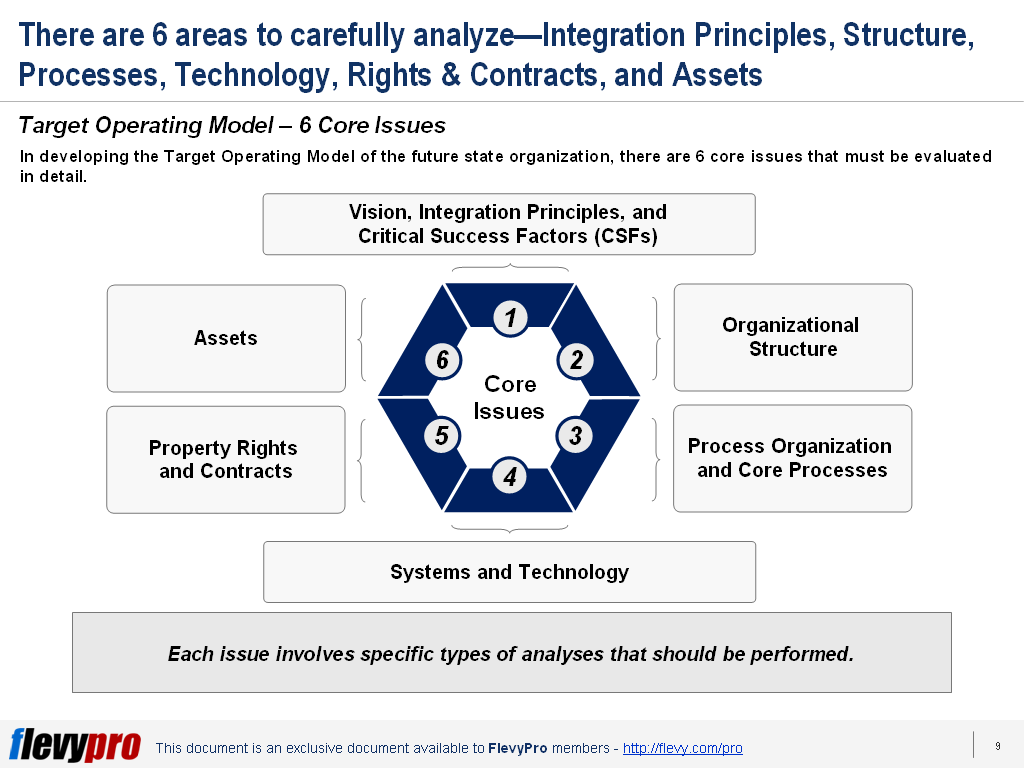Editor's Note: Take a look at our featured best practice, M&A Sell-Side Process Letter - Phase I and Phase II (5-page Word document). What is the M&A process letter?
The M&A process letter is a template or example which assists transaction advisory consultants, investment bankers, and M&A practitioners with a sound basis from which to outline the proposed transaction steps in an M&A process.
As the M&A process progresses [read more]
Also, if you are interested in becoming an expert on Post-merger Integration (PMI), take a look at Flevy's Post-merger Integration (PMI) Frameworks offering here. This is a curated collection of best practice frameworks based on the thought leadership of leading consulting firms, academics, and recognized subject matter experts. By learning and applying these concepts, you can you stay ahead of the curve. Full details here.
* * * *
When organizations go into Mergers & Acquisitions (M&A), its future operating state changes. A fundamental question will  arise as to what the Target Operating Model (TOM) of the resultant organization will look like.
arise as to what the Target Operating Model (TOM) of the resultant organization will look like.
What is TOM?
The Target Operating Model (TOM) represents a clearly defined target structure in which the relevant unit should operate in the future. It consists of the structural and process organization as well as the assets needed and the contractual regulation required both internal and external.
The Mission Statement of the Target Operating Model (TOM) is to provide a clear overview of the changes in the course of the Transformation related to the organizational structure and business processes, as well as the assets and contract.
The Target Operating Model is your blueprint. While the design process for Merger and Acquisition may be the same, the approval process is different. For Joint Ventures, the approval process is more extensive due to the issues of governance as well as revenue/cost-sharing. Hence, it is essential for organizations to have a good understanding of the 6 Core Issues essential in developing the Target Operating Model.
The 6 Core Issues in Developing a Target Operating Model
Each core issue must address specific key questions that are raised. Likewise, each issue involves specific types of analysis that should be performed. This is essential for an organization to make when going through the Integration process. As a purview, let us look at the key questions that may be raised.

- Vision, Integration Principles, and Critical Success Factors (CSFs)
Is there a comprehensive understanding of the vision and deal strategy/rationale, as well as the Integration Principles and their critical success factors?
- Organizational Structure
What is the current organizational structure and that of the target organization?
- Process Organization and Core Processes
How are the process organization and core processes currently set up and how will they be in the target organization?
- Systems and Technology
What technologies/systems are currently and will be required in the future?
- Property Rights and Contracts
What important property rights and contract do currently exist and will be required in the future?
- Assets
What assets do currently exist and will be required in the future?
Organizations must take a closer look at the key questions and the analyses behind each of the 6 Core Issues. Each core issue has an analytical framework that serves as its guidepost in going through the process. This is to ensure that the core issues are well analyzed before the organization takes on the final step of constructing its Target Operating Model. When this is properly defined, only then will an effective and strategic Target Operating Model can be constructed and put into operation.
Albeit it to say, however, the development of the Target Operating Model is not an easy task. Organizations will encounter several pitfalls as they go through the process of Transformation. It can be a lack of clear and coherent vision and deal rationale with regard to the future business model. This can be a deterrent to the success of a TOM and the target value generation.
Interested in gaining more understanding of the Target Operating Model? You can learn more and download an editable PowerPoint about Mergers and Acquisitions (M&A): Target Operating Model (TOM) here on the Flevy documents marketplace.
Do You Find Value in This Framework?
You can download in-depth presentations on this and hundreds of similar business frameworks from the FlevyPro Library. FlevyPro is trusted and utilized by 1000s of management consultants and corporate executives. Here’s what some have to say:
“My FlevyPro subscription provides me with the most popular frameworks and decks in demand in today’s market. They not only augment my existing consulting and coaching offerings and delivery, but also keep me abreast of the latest trends, inspire new products and service offerings for my practice, and educate me in a fraction of the time and money of other solutions. I strongly recommend FlevyPro to any consultant serious about success.”
– Bill Branson, Founder at Strategic Business Architects
“As a niche strategic consulting firm, Flevy and FlevyPro frameworks and documents are an on-going reference to help us structure our findings and recommendations to our clients as well as improve their clarity, strength, and visual power. For us, it is an invaluable resource to increase our impact and value.”
– David Coloma, Consulting Area Manager at Cynertia Consulting
“As a small business owner, the resource material available from FlevyPro has proven to be invaluable. The ability to search for material on demand based our project events and client requirements was great for me and proved very beneficial to my clients. Importantly, being able to easily edit and tailor the material for specific purposes helped us to make presentations, knowledge sharing, and toolkit development, which formed part of the overall program collateral. While FlevyPro contains resource material that any consultancy, project or delivery firm must have, it is an essential part of a small firm or independent consultant’s toolbox.”
– Michael Duff, Managing Director at Change Strategy (UK)
“FlevyPro has been a brilliant resource for me, as an independent growth consultant, to access a vast knowledge bank of presentations to support my work with clients. In terms of RoI, the value I received from the very first presentation I downloaded paid for my subscription many times over! The quality of the decks available allows me to punch way above my weight – it’s like having the resources of a Big 4 consultancy at your fingertips at a microscopic fraction of the overhead.”
– Roderick Cameron, Founding Partner at SGFE Ltd
“Several times a month, I browse FlevyPro for presentations relevant to the job challenge I have (I am a consultant). When the subject requires it, I explore further and buy from the Flevy Marketplace. On all occasions, I read them, analyze them. I take the most relevant and applicable ideas for my work; and, of course, all this translates to my and my clients’ benefits.”
– Omar Hernán Montes Parra, CEO at Quantum SFE

28-slide PowerPoint presentation
For any business looking to engage in acquisition activity, it is critical to understand what your strategy is. Acquisition and investment is more than a financial exercise, there has to be a strategy intent as well.
This document is in three main sections to help formulating an acquisition
[read more]
Want to Achieve Excellence in Post-merger Integration (PMI)?
Gain the knowledge and develop the expertise to become an expert in Post-merger Integration (PMI). Our frameworks are based on the thought leadership of leading consulting firms, academics, and recognized subject matter experts. Click here for full details.
M&A is an extremely common strategy for growth. M&A transactions always look great on paper. This is why the buyer typically pays a 10-35% premium over the of the target company's market value.
However, when it comes time for the Post-merger Integration (PMI), are we really able to capture the expected value? Studies show only 20% of organizations capture projected revenue synergies and only 40% capture cost synergies. Not to mention, the PMI process is typically very painful, drawn out, and politically charged, often resulting in the loss of key personnel.
Learn about our Post-merger Integration (PMI) Best Practice Frameworks here.
Readers of This Article Are Interested in These Resources

24-slide PowerPoint presentation
Seventy percent of change programs fail, according to the April 2001 Harvard Business Review article, "Cracking the Code of Change". According to Bain & Company, businesses that implement fast, focused, and simultaneous change programs can create enormous and long-lasting shareholder value.
[read more]

4-page Word document
A non-binding offer letter is used in a sales process to establish the terms of a deal between the seller and the buyer. Through the document, the potential acquirer expresses an interest to acquire the target, but the document is not intended to be legally binding and therefore, it does not
[read more]

32-slide PowerPoint presentation
In an M&A situation, a fundamental question is what the Target Operating Model (TOM) of the resultant organization will look like. This framework addresses the topic of TOM Development in an M&A.
In formulating the Target Operating Model, there are 6 core areas that must be analyzed in an
[read more]

Excel workbook
This excel provides a DCF valuation template which is a valuation method where future cash flows are discounted to present value. The valuation approach is widely used within the investment banking and private equity industry.
This DCF valuation model includes comprehensive financial metrics, such
[read more]
 arise as to what the Target Operating Model (TOM) of the resultant organization will look like.
arise as to what the Target Operating Model (TOM) of the resultant organization will look like.




